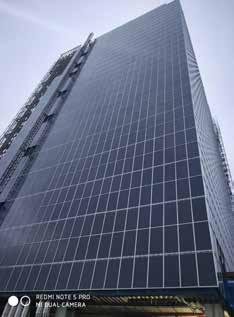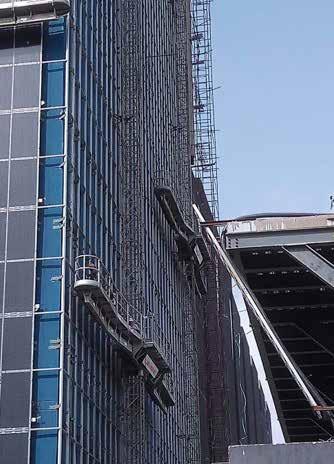
10 minute read
Applications of BIPV Technology in India - World’s Largest BIPV Project & Commercial Viability for Future K.R Harinarayan, CEO & Founder, U-Solar Clean Energy
Applications of BIPV Technology in India World’s Largest BIPV Project & Commercial Viability for Future
BUILDING INTEGRATED PHOTO-VOLTAICS - GLOBAL CONTEXT
Advertisement
The BIPV (Building I n t e g r a t e d
Photovoltaics) method includes the replacement of the traditional construction element with materials incorporating solar modules. This offers a dual function, namely to produce energy and to provide a functional and aesthetic construction element for the finished building. It has been proven by the European commission that introducing photovoltaics improves the energy efficiency of the building, if done properly. Moreover, as of now the market has matured for the technology in regions like USA,
Europe, China so far so that the market for BIPV modules could be worth $5 billion in USA alone. There are various methods by which BIPV can be used in buildings, viz. glazes, tiles, façades, and cladding. India has to some extent or the other used all of these methods to integrate solar PV into building features.
The installations in the west are
Solar façades - GDF Suez at Dijon, Bourgogne (Source - ISSOL; Atelier Phileas)
now proving the feasibility of the technology by i) improvement in ventilation for BIPV installations to reduce panel temperature and ii) development of new thin film technology that are better suited for integration.
INTRODUCTION OF BIPV IN INDIA, LARGEST IN THE WORLD CtrlS Datacentre Ltd., Mumbai
Many BIPV projects started coming up in India since 2017 onwards. These were mainly for smaller solar projects such as homes. In 2019,

GDF Suez at Dijon, Bourgogne – another view of solar façades (Source - ISSOL; Atelier Phileas)


a project which made history in Mumbai, as the largest BIPV plant in India, and possibly in the world, was commissioned. The first ever such system was constructed for a data centre done by CtrlS Datacentres Ltd. As the building is cemented on all four sides, a glass façade was considered essential to add to its aesthetic appeal. But instead of applying regular façade covering glass, the client chose to install 2,466 high-efficiency monocrystalline-Building Integrated Photovoltaic (BIPV) series WSM 350 Wp Waaree frameless solar panels and module level optimisations was carried out to with the help of MPPT optimizers.
The misconception about low generation for BIPV can be proven wrong, with results achieved by introducing smart technology such as Solar Edge inverters, as used in our installation at the datacentre can substantially increase energy generation and allow for module level monitoring. Custom designed aluminium rails were used as the module mounting structure. The result is a 863.1 kWp capacity solar power generating façade. The solar power plant has a Performance Ratio of 75%, which is well higher
CtrlS Datacentres Ltd, Mumbai - India's Largest BIPV Datacentre
than the simulated PV Syst report when it was planned. With an average generation of 40,000 – 55,000 kWh per month, the solar power plant is able to offset enough carbon to sequester 7000 trees per year. More buildings can choose to integrate this technology on their structures, with a generation of 6,00,000 units per MWp it is possible to offset the lighting loads with clean energy. Green building certification codes also include solar power as a metric, which is beneficial in case a company uses BIPV technology. As BIPV installation is quite challenging and
CtrlS Datacentres Ltd, Mumbai – with the installation of 2,466 high-efficiency mono-crystalline-Building Integrated Photovoltaic (BIPV) series WSM 350 Wp Waaree frameless solar panels



Installation details - CtrlS Datacentre Ltd


FACT FILE: Project Name: India's Largest BIPV Datacentre - CtrlS Datacentre Ltd Location: Mumbai, India Client: CtrlS Datacentre Ltd. Inverter Supplier: Solar Edge
Module Supplier:
Waaree
Materials used for façade & fenestration:
Aluminium façade
Commencement Date & Completion
Date: August 2019 - December 2019
needs expert design experience to integrate as a façade glass the project would have to be planned at the initial designing with the architect or modelling stage to avoid any rework.
COMMERCIAL VIABILITY AND NZEB TECHNOLOGY
The BAPV* (Building Applied Photovoltaics) method consists of fitting modules to existing surfaces via superimposition once construction has been completed, such as during an energy renovation project. This is currently the trend in Europe and North America, wherein the older

buildings are being renovated and retro-fitted with PV panels. Thin film and coloured glass photovoltaic panels allow architects the ability to design aesthetically pleasing buildings, such examples can be seen in the La Cub building at Bordeaux or GDF Suzon in Dijon (see pictures attached). The debate around commercial viability is based on the one-time cost of the installation and does not account into the benefit provided by energy generation, energy efficiency and sustainability value. For a commercial building/ urban structure build to last over 50 years, it is better to have a solar power plant that adds value to the structure for half its lifetime. A BIPV installation typically has a payback of approximately 5 years (depending on the DISCOM tariff) and it will generate free electricity for the remainder of its lifetime for approximately 20 years. As better panels are introduced in the market, we estimate that the lifetime of a solar power plant will also increase. Moreover, a good operations and maintenance contract will

allow for better performance of
La Cub Building, GDF Suzon Building (Source: SUPCI)
the system over time. Providing energy efficiency reports in many developed countries is the norm for contractors, which acts as an incentive to adopt the technology. There are also subsidies for procurement of these modules as well as façades provided by various governments to promote the integration into urban, industrial, institutional and agricultural buildings. The increasing popularity of net zero buildings (nZEB) are a motivation for many to look into adopting BIPV technology, architects are closely working with energy companies in Dubai, Singapore and China to make world class nZEB facilities. Trailing close behind, is India... (*both terms BIPV and BAPV are used interchangeably)
TYPES BIPV/BAPV APPLICATION IN BUILDINGS
Application techniques may vary depending on the architecture of the building, so BIPV is usually developed with multiple designers working together. Tiles and glazes are used in smaller projects, where the roof can be replaced with a BIPV panel or the glass can be replaced with a BIPV glass. Both of these technologies are not yet feasible in India as we do not currently have manufacturers producing large quantum of translucent or transparent colored glass. However, we estimate that within the next two years there will be European entrants who will provide these to the Indian market. However, with respect to opaque BIPV panels, India does have a few manufacturers who are competing in a niche space. Solar glass as a replacement for façade glass will be the next-generation BIPV as façade glass technology. Since fixing structure and glass installation is already planned, replacing with solar glass makes it techno-commercially viable. These (modules or glass) can be fitted into framed façades as a replacement for spandrel or vision glass respectively, inside window frames to reduce glare as well as retrofit applications where external mounting is possible.
1. Cladding-based application:
These PV spandrels are fitted into a façade that is designed based on the specifications and have the panels mounted onto them. Trenches will have to be developed to maintain consistent wiring for ease of remote monitoring and electrical maintenance. Based on the amount of natural light required the panel can be placed*. 2. Curtain wall application: This is a BIPV system which can replace all of the glass in the façade but uses a different kind of panel that allows maximum penetration of wall.
It is extremely aesthetic and can find applications in many kinds of structures such as office spaces, museums, malls, public offices and many more developmental buildings.
3. Window-based application:
Solar panels can also replace window glass, called transparent skylight or PV canopy types of installations allow more light to pass through and are a very good replacement for vision glass in buildings. Generally used in urban buildings and homes window based BIPV have a huge potential to disrupt the way we view modern construction.
4. Retrofitting application:
Many design aspects of a building can accommodate the integration of PV, which are not direct to replacing glass or windows. Some of these can include thin film PV placed on walls. Surfaces that can be covered with a BIPV glass over carbon fibre, steel, or concrete structures, especially in modern designs. 5. PV rooftop application: The more popular technology known as rooftop solar plants can be integrated into a building through its structure.
There are methods to replace the roofing material with a concrete PV panel acting as both the roof as well as the solar power plant. This is one of the best ways to get facilities in

Curtain wall, ventilated façade (Source: Onyx Solar)
the industrial sector to adopt
BIPV. (*In buildings where the brightness is mandated, there are also ways to use zig-zag frames to allow light penetration.)
FUTURE OF BIPV IN INDIA: TECHNOLOGY & SUPPORT
U-Solar Clean Energy has been working with façade consultants, knowledge partners and architects to develop more of these kinds of project in India. U-Solar’s experience and expertise in working with cross functional teams in their previous project will allow smooth designing and installation. With the learnings from existing implementation around the world they hope to bring this technology to India by working with the best in the industry. As accredited installers for Onyx Solar (a global leader in the development and manufacture of photovoltaic glass for buildings), the company is confident that more of these Dubai Frame (Source: Onyx Solar) one-of-a-kind installations shall emerge in the near future. With the right support from the Government of India, the BIPV market can take off like it has abroad. There is huge scope for implementing this technology as India has a dense population that forces construction of highrise buildings in its metropolitan cities. They also hope that the commercials will become more attractive as more developers begin to adopt the technology as the scale at which manufacturing and installation will drive costs

PV rooftop application
down as technology improves.


K.R. HARINARAYAN
CEO & Founder, U-Solar Clean Energy
ABOUT THE AUTHOR:
Driven by a desire to start a socially relevant enterprise, K.R. Harinarayan founded U-Solar Clean Energy in 2010. With a strong vision for a renewable energy-focused future U-Solar holds on a deep and abiding belief that renewable energy with its advantages in distributed generation, short turnaround times, clean origins is the answer to a multitude of problems ailing the power sector in India. Leading a team of 60 engineers and managers to push the envelope in the solar rooftop market. Operating across India, the company has installed 100 MWp solar projects. Since 2018, the company has installed 5 MWp of their own assets and officially became an independent power producer. U-Solar works with innovative solar integration technologies by constantly pushing the envelope for adoption of distributed captive power plants and hopes to achieve 500 MWp by 2025, positioning itself as one of India's premiere clean energy providers for distributed renewable energy.









